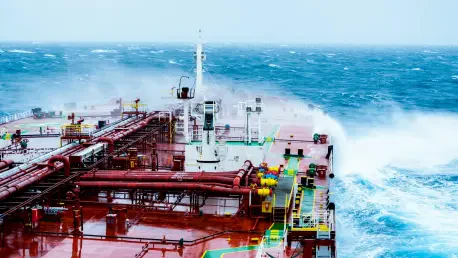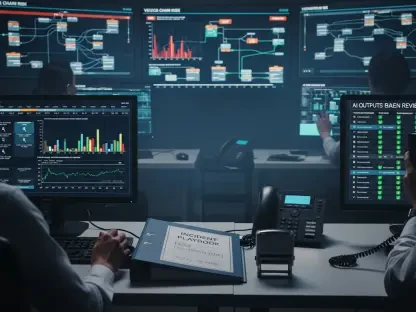In the ever-evolving landscape of maritime security, Simon Glairy stands out as a renowned expert in insurance and Insurtech, particularly focusing on risk management and AI-driven risk assessment. With geopolitical tensions and shadow fleet activities increasingly affecting global shipping, Simon provides insight into these pressing challenges and what they mean for the industry at large.
Can you explain the recent collision between the Adalynn and Front Eagle off the coast of the United Arab Emirates?
The recent collision between Adalynn and Front Eagle has spotlighted the ongoing maritime security issues in the Gulf. Taking place 24 nautical miles east of Khor Fakkan, the incident involved the Adalynn, a potentially uninsured vessel and part of the “dark fleet,” and the Front Eagle, operated by one of the largest tanker firms globally. Although all crew members were rescued, the resulting fires on both tankers have heightened concerns among insurers and the shipping market, especially given the intricate geopolitical backdrop and instances of navigational jamming in the area.
What is the “dark fleet,” and what role did it potentially play in this incident?
The “dark fleet” consists of aging tankers primarily utilized for illicit trades, often linked to sanction evasion. These vessels frequently use flags of convenience and eschew standard regulations, including operational transponders and necessary maintenance. In the context of the Adalynn’s collision, its possible inclusion in this fleet raises alarms over safety norms and accountability, considering its likely lack of insurance and maintenance.
How prevalent is the shadow or “dark fleet” in the global shipping industry today?
The shadow or “dark fleet,” as highlighted in recent Allianz reports, now makes up approximately 17% of the global tanker population. This growth is staggering when you consider these vessels were practically nonexistent a few years back. The rising number of such fleet highlight concerns around safety, environmental risks, and market stability.
Since when have we observed an increase in incidents involving the “dark fleet,” and what are some of the most notable types?
The shadow fleet’s involvement in maritime incidents has noticeably increased. Over 50 notable incidents have occurred recently. These range from major fires and collisions like the one involving the Adalynn to groundings in crucial maritime zones. The rise in incidents underscores the need for regulatory oversight and the potential dangers these vessels represent to maritime safety and the environmental ecosystem.
What risks do uninsured or poorly maintained shadow fleet vessels pose to maritime safety and the environment?
The risks posed by uninsured shadow fleet vessels are multifaceted. They increase the likelihood of incidents due to poor maintenance, which in turn presents significant environmental threats, particularly oil spills with cleanup costs estimated up to US$1.6 billion. Such financial ramifications extend beyond potential environmental damage, affecting stakeholders who might have limited avenues for claims.
How does the lack of liability coverage for shadow fleet vessels affect other stakeholders such as cargo owners and port facilities?
Without liability coverage, shadow fleet vessels place the burden of risk on parties including cargo owners and port facilities. In case of damage or spills, these stakeholders may find themselves without the usual recourse to insurance claims, further complicating an already precarious situation and creating significant financial exposure for everyone involved.
Why is the Strait of Hormuz considered a critical chokepoint for global oil supply?
The Strait of Hormuz is of paramount importance because it serves as a conduit for nearly a fifth of global petroleum flows. Its strategic relevance means any disturbances could ripple through the global oil supply, bringing economic and political ramifications to countries worldwide dependent on its safe and uninterrupted transit.
How do geopolitical tensions and conflicts in the region impact shipping routes like the Strait of Hormuz?
Geopolitical tensions significantly exacerbate risks along vital shipping routes including the Strait of Hormuz. Proxy conflicts, sanctions, and targeted attacks turn these areas into operational minefields, impacting regular trade flows and heightening wariness among maritime operators about potential vessel seizures or sabotage.
What kind of navigational challenges are vessels like the Front Eagle facing in these high-risk zones?
Navigational challenges in high-risk zones are becoming increasingly complex due to factors like congestion, geopolitical disturbances, and technological interferences such as jamming. Vessels like the Front Eagle face the constant threat of unplanned disruptions, which can result in substantial operational risks.
How have incidents of fires or explosions in the shipping industry changed recently, according to Lloyd’s List data?
According to Lloyd’s List, incidents involving fires or explosions have soared, witnessing a 20% increase in 2024. This uptick marks the highest figures in the past decade, underscoring the evolving risk landscape faced by marine operators.
How are war risk premiums for marine insurance being affected by current geopolitical tensions?
Current geopolitical tensions are pushing war risk premiums upward as regions such as the Gulf continue to face volatility. This financial stress on marine insurance markets is underpinned by rising claims related to conflicts, which amplify the burdens on underwriting practices.
What are the challenges faced by marine underwriters in dealing with both traditional maritime risks and new geopolitical threats?
Marine underwriters face the daunting task of balancing conventional maritime risks like collision or mechanical failure with emergent geopolitical threats. The evolving landscape demands innovative risk assessment strategies and expanded coverage parameters to adapt to increasingly complicated exposure scenarios.
How might the collision involving the Adalynn and Front Eagle affect global tanker market rates and operations?
The incident has already led to a noticeable increase in Gulf transit rates. As operators reassess their risk thresholds, it spurs a broader dialogue on vessel routing and insurance adequacy, influencing global tanker market dynamics and operational strategies.
In what ways are operators reassessing their risk assessment and insurance coverage for routes through high-risk zones like the Gulf?
Operators are reevaluating their risk metrics, giving greater attention to transparency regarding vessel flags and the adequacy of their insurance coverage. High-risk zones necessitate meticulously crafted risk assessments that accommodate the nuanced challenges posed by geopolitical and economic volatility.
Although the collision near Khor Fakkan may have been accidental, what does it indicate about the potential for escalation in today’s maritime environment?
The collision serves as a stark reminder of escalating tensions in maritime environments. The thin line between accidental incidents and deliberate aggression continues to blur, necessitating heightened vigilance and proactive risk management strategies to mitigate potential escalations effectively.
What is your forecast for new developments in the sector?
Looking ahead, I anticipate continued advancements in technology to better monitor and manage maritime risks, especially concerning shadow fleets. However, geopolitical conflicts may drive a sustained rise in insurance premiums as stakeholders strive to balance innovation with unpredictability.









